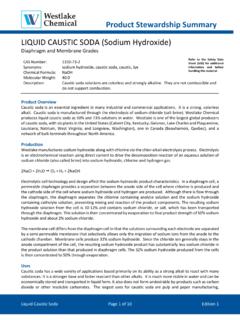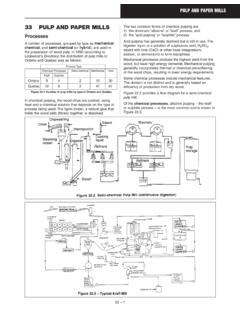Transcription of LIQUID CAUSTIC SODA (Sodium Hydroxide)
1 Product Stewardship Summary LIQUID CAUSTIC soda Page 1 of 10 Edition 1 LIQUID CAUSTIC soda (Sodium Hydroxide) Mercury Grade CAS Number: 1310-73-2 Synonyms: sodium hydroxide, CAUSTIC soda , CAUSTIC , lye Chemical Formula: NaOH Molecular Weight: Description: CAUSTIC soda solutions are colorless and strongly alkaline. They are not combustible and do not support combustion. Product Overview CAUSTIC soda is an essential ingredient in many industrial and commercial applications. It is a strong, colorless alkali. CAUSTIC soda is manufactured through the electrolysis of sodium chloride (salt brine). Westlake Chemical produces LIQUID CAUSTIC soda as 50% and 73% solutions in water. Westlake is one of the largest global producers of CAUSTIC soda , with six plants in the United States (Calvert City, Kentucky; Geismar, Lake Charles and Plaquemine, Louisiana; Natrium, West Virginia; and Longview, Washington), one in Canada (Beauharnois, Quebec), and a network of bulk terminals throughout North America.
2 Production Westlake manufactures sodium hydroxide along with chlorine via the chlor-alkali electrolysis process. Electrolysis is an electrochemical reaction using direct current to drive the decomposition reaction of an aqueous solution of sodium chloride (also called brine) into sodium hydroxide, chlorine and hydrogen gas. 2 NaCl + 2H2O Cl2 + H2 + 2 NaOH There are several variations in electrolytic cell design which effect product characteristics. Westlake Chemical employs all three cell types, diaphragm, mercury, and membrane, in production of LIQUID CAUSTIC soda . The mercury cell design is substantially different from the other two. (For details regarding the diaphragm and membrane cell process, please refer to Westlake Chemical s LIQUID CAUSTIC soda Diaphragm and Membrane Grades Product Stewardship Summary.) Rather than chlorine and sodium hydroxide being formed simultaneously in one cell, two distinct processes are employed to form the CAUSTIC solution.
3 In the mercury cell, sodium brine flows between a stationary anode and a moving mercury metal cathode. Chlorine is produced at the anode, but the mercury cathode forms an amalgam with the newly formed sodium metal. This reaction takes place on the surface of the mercury with energy driving the reaction. 2Na+ + 2Cl- + 2Hg 2Na-Hg + Cl2 This amalgam is fed to another cell for decomposition. It reacts with water to form the CAUSTIC solution and hydrogen gas, reforming the mercury to be recycled as cathode for the original electrolytic cell. 2Na-Hg + 2H2O 2 NaOH + H2 + 2Hg This resulting sodium hydroxide aqueous solution is very high purity, and has very low salt content. After the initial energy output in the mercury cell, little additional energy is required to finish the product as the CAUSTIC is recovered at approximately 50% concentration from the mercury amalgam. Refer to the Safety Data Sheet (SDS) for additional information and before handling this material.
4 Product Stewardship Summary LIQUID CAUSTIC soda Page 2 of 10 Edition 1 Uses CAUSTIC soda has a wide variety of applications based primarily on its ability as a strong alkali to react with many substances. It is a stronger base and faster reactant than other alkalis. It is much more stable in water and can be economically stored and transported in LIQUID form. It also does not form undesirable by-products such as carbon dioxide or other insoluble carbonates. The largest uses for CAUSTIC soda are pulp and paper manufacturing, alumina production, de-inking of waste paper, water treatment, and general chemistry. CAUSTIC soda is a basic feedstock in the manufacture of a wide range of chemicals. It is used as an intermediate and a reactant in processes that produce solvents, plastics, synthetic fibers, bleach, adhesives, coatings, herbicides, dyes, inks, and pharmaceuticals such as aspirin.
5 It is also used in soap and detergent, oil and gas, and textile industries as well as to neutralize acidic waste streams and the scrubbing of acidic components from off-gases. With all downstream applications, appropriate registrations and/or approvals may be required. Possible uses are described below: Chemical Production - The chemical industry consumes nearly 40% of the CAUSTIC soda produced as a basic reagent for a multitude of general industrial applications. Pulp and Paper - Both sulfate and sulfite pulps are purified by removing lignin compounds in the CAUSTIC extraction stages of multistage bleach plants. In some kraft mills, CAUSTIC soda is used as a makeup chemical. It is also used as the initial treatment in de-inking secondary fibers. Rayon and Cellophane - Fiber production by the viscose process requires CAUSTIC soda at two main stages. Cellulose is treated with CAUSTIC soda solution to mercerize it and form alkali cellulose, which is then dissolved in dilute CAUSTIC soda solution to form viscose prior to extruding rayon fibers and cellophane films.
6 Alumina Extraction - CAUSTIC soda is used to digest bauxite ore, precipitating alumina (aluminum oxide). It is also used as an etchant in the finishing and chemical milling of aluminum products. Soapmaking - CAUSTIC soda saponifies fats into water soluble sodium soaps. Textiles - Used in scouring, bleaching, desizing, lustering and mercerizing. Petroleum Production and Refining - CAUSTIC soda is used as an absorbent for carbon dioxide in light petroleum fractions; as an absorbent for sulfides in the purification of various fractions; and with chlorine for hypochlorite sweetening, a treatment step in the removal of various sulfur compounds. soda Ash Replacement - CAUSTIC soda can be used interchangeably for many applications in glass, paper, pulp, phosphates and silicates industries. Renewable Fuels - CAUSTIC soda is used for pH adjustment and formation of in situ sodium methylate in bioethanol and biodiesel processing.
7 Health Effects Read and follow all instructions on the product label and review the Safety Data Sheet (SDS) to understand and avoid the hazards associated with CAUSTIC soda . Wear appropriate personal protective equipment and avoid direct contact. Eye contact with CAUSTIC soda causes serious eye damage including irreversible damage and blindness. Skin contact causes severe burns. Ingestion of CAUSTIC soda may cause irreversible damage to gastrointestinal mucous membranes, upper airway edema and is often life threatening. Inhalation of CAUSTIC soda may cause cough and bronchospasm. Inhalation of high concentrations may cause irreversible damage, including upper airway edema and corrosive burns. The United States Occupational Safety and Health Administration (OSHA) and the American Conference of Governmental Industrial Hygienists (ACGIH) have established or recommended occupational airborne exposure limits for CAUSTIC soda .
8 The OSHA Permissible Exposure Limit (PEL) is an 8 hour Time-Weighted Average (TWA) of 2 mg/m3 (milligrams per cubic meter). The ACGIH Threshold Limit Value (TLV) is a Ceiling Limit of 2 mg/m3. A Ceiling Limit should not be exceeded during any part of the working exposure. Product Stewardship Summary LIQUID CAUSTIC soda Page 3 of 10 Edition 1 Before handling, it is important that engineering controls are operating and protective equipment requirements and personal hygiene measures are being followed. People working with this chemical should be properly trained regarding its hazards and its safe use and should be given the opportunity to review this document and the safety data sheet. Environmental Effects CAUSTIC soda should be kept out of lakes, streams, ponds, or other water sources. CAUSTIC soda does not bioaccumulate due to its high solubility in water. Exposure Potential Precautions should be taken to minimize potential harm to people, animals and the environment.
9 Potential for exposure may vary depending upon site-specific conditions. When handling CAUSTIC soda , refer to the Safety Data Sheet and Product Warning Label and follow all instructions and warnings. Based on the expected uses for CAUSTIC soda , exposure could be through: Workplace exposure - Exposure can occur either in a CAUSTIC soda manufacturing facility or in the various industrial facilities that use CAUSTIC soda . CAUSTIC soda has been used for more than 100 years by industry. When exposures occur, they are most frequently to the skin and eyes, although oral exposure and ingestion are possible. Good industrial hygiene practices and the use of personal protective equipment will, when combined with proper training and environmental, health and safety practices, mitigate exposures and ensure a safe work environment. Additionally, most processes using CAUSTIC soda use closed tanks and vessels.
10 Environmental releases - In the event of a spill, contain the spill to prevent contaminated soil, surface or ground water. CAUSTIC soda can significantly increase the pH of soil and/or water. Industrial spills (releases to soil or water) should be controlled by workplace spill programs which include containment around loading and unloading operations and storage tanks and employee training. Many aspects of a spill control program are mandated by federal, state and local requirements. In addition, if a spill occurs, governmental reporting may be required. Refer to the Safety Data Sheet for instructions to contain and clean up a spill to minimize exposure. Consumer exposure - CAUSTIC soda is not sold directly to consumers; however it is an ingredient in some consumer products. Westlake cannot and does not make any representation or conclusion about consumer exposure risks associated with its customers products.











